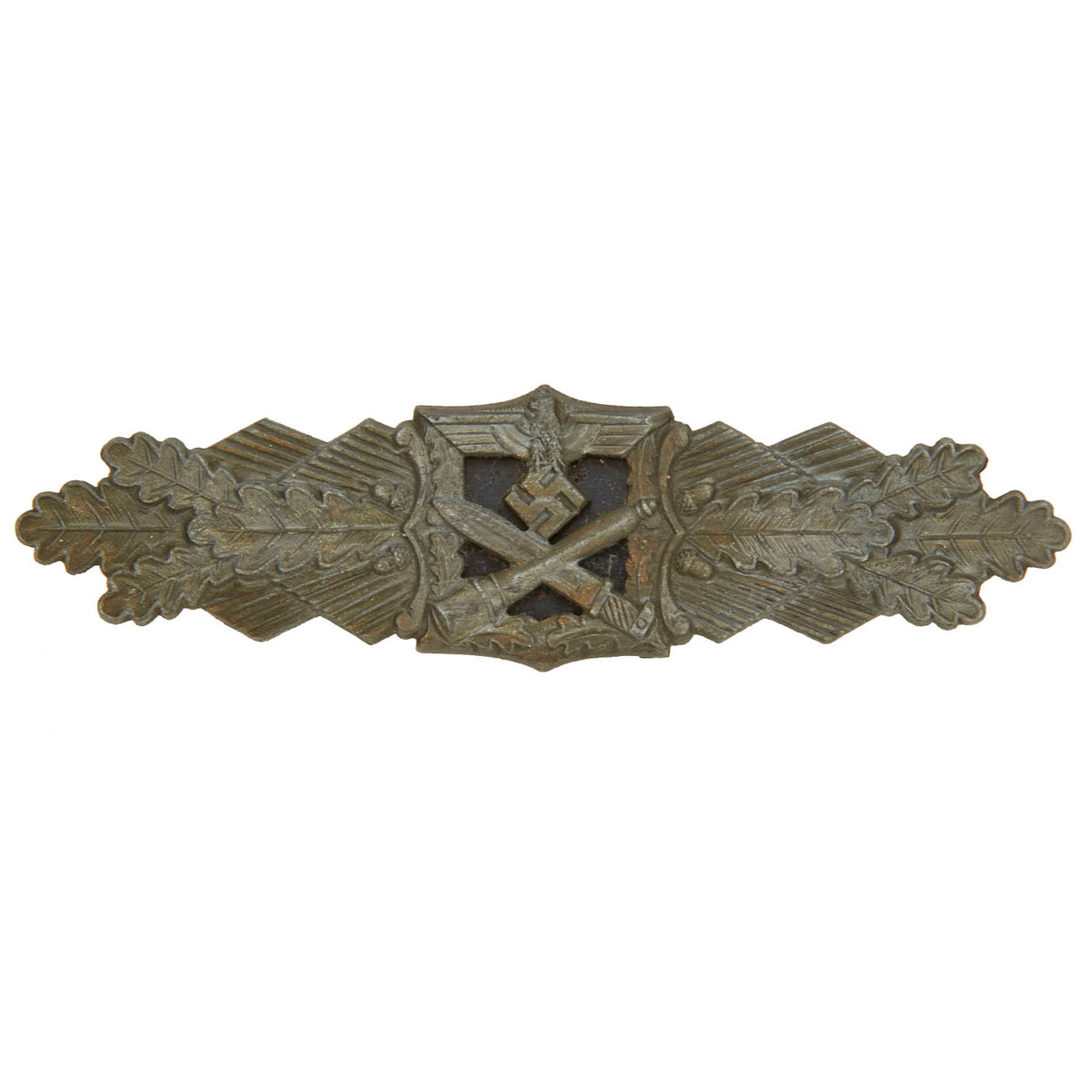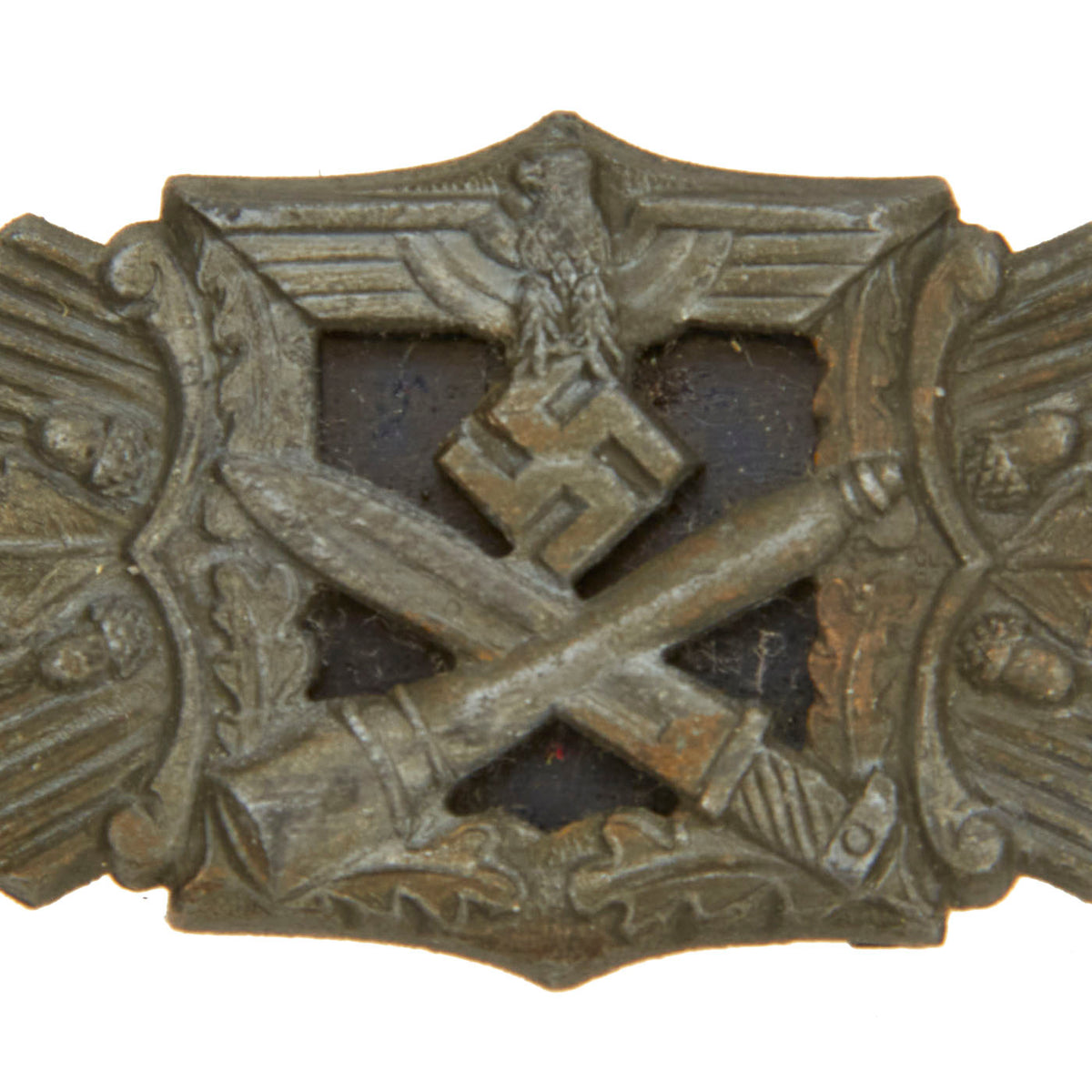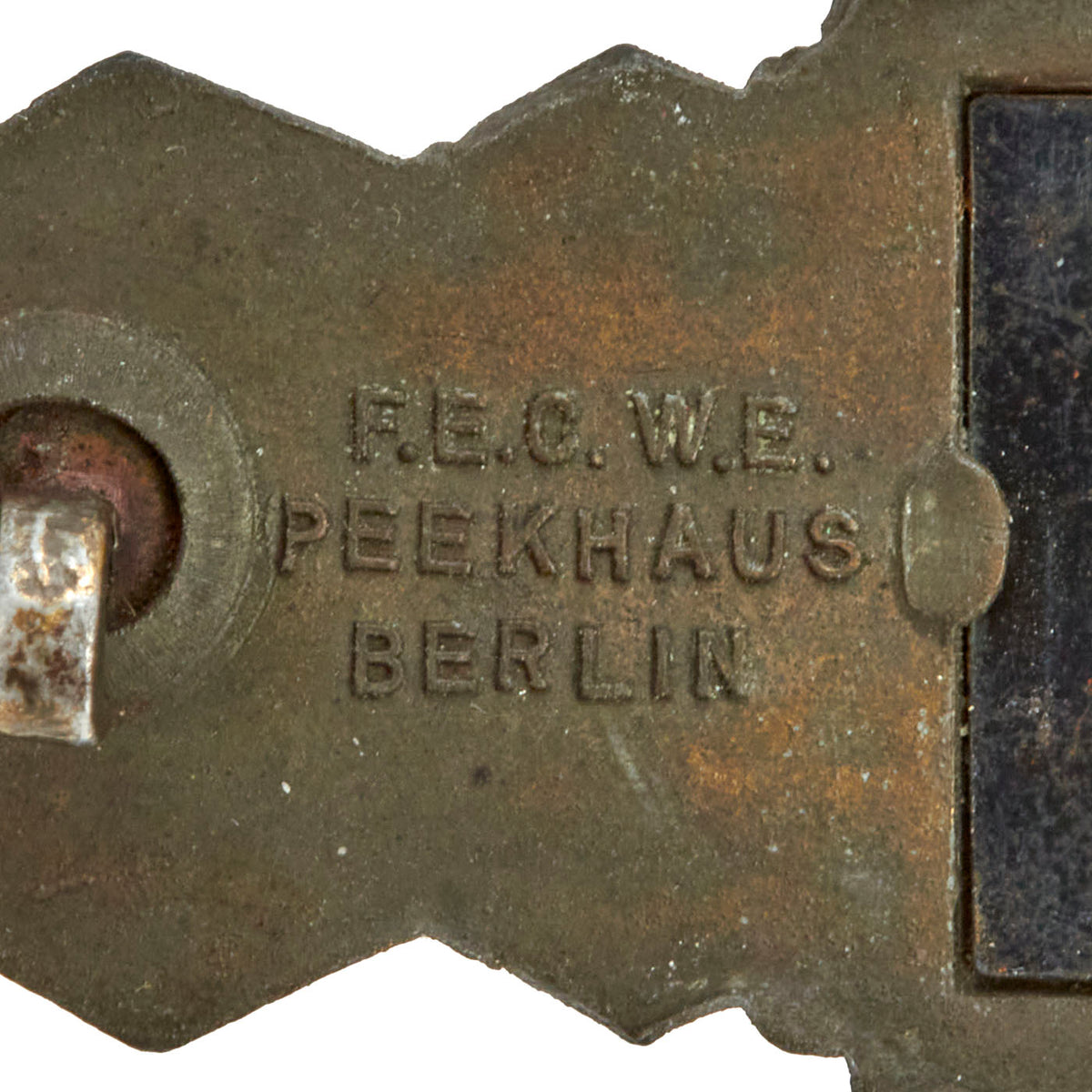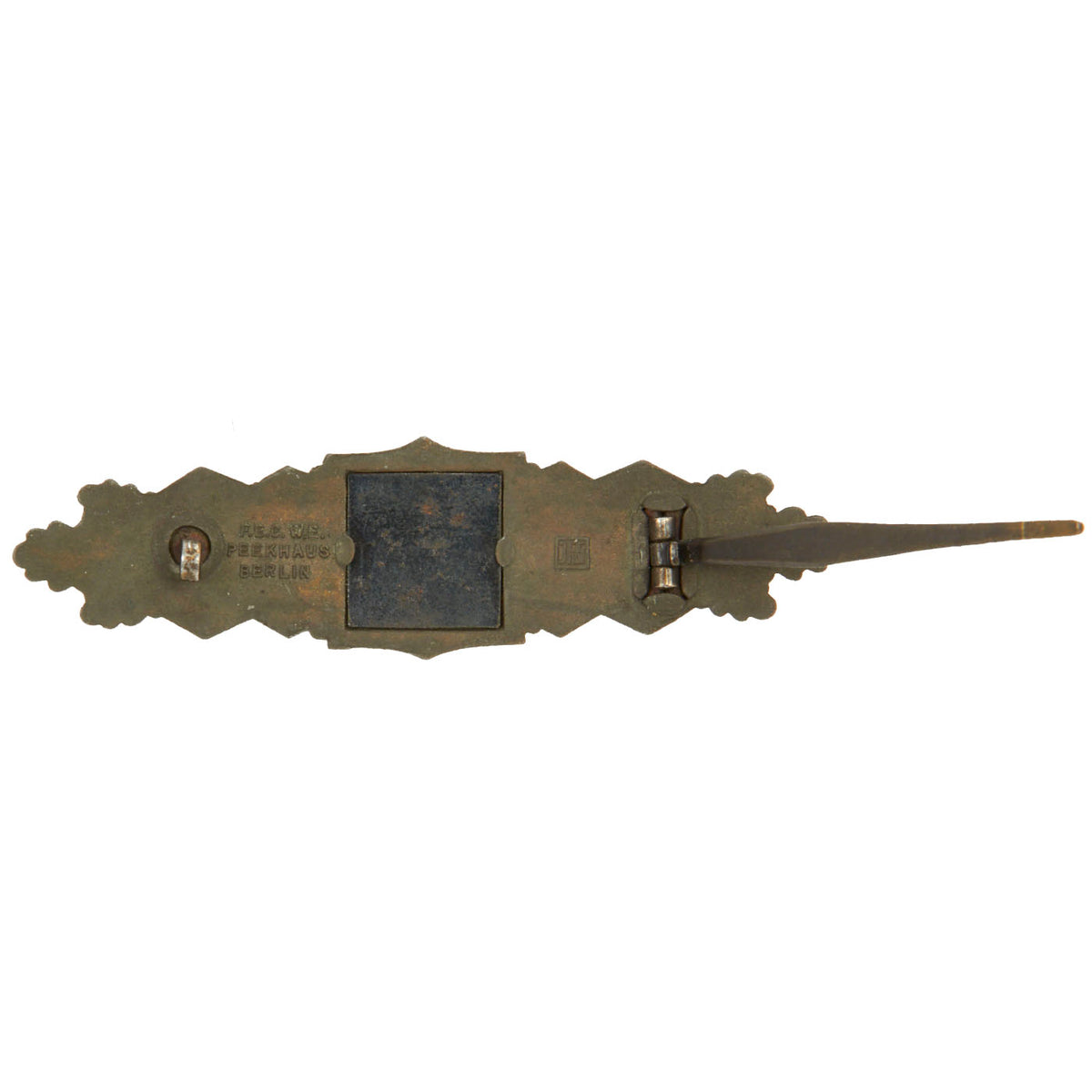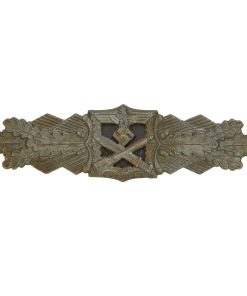Original German WWII Close Combat Clasp in Bronze by FEC. W. E. Peekhaus – Josef Feix & Söhne 2nd Pattern Nahkampfspange Original Items
$ 550,00 $ 165,00
Original Item: Only One Available. Original Item: Only One Available. Known in German as a Nahkampfspange (Melee Clasp) in Bronze, this fine award is constructed of bronzed slightly vaulted zinc. The front side has a Reichsadler (national eagle) over a crossed bayonet and hand grenade in the centerpiece. There are sun rays emanating from the center of the left and right sides, with four oak leaves and two acorns on each side. The reverse is plain, with a square non-magnetic backing plate with horizontal pin back, with a barrel hinge and a flat wire catch on the reverse. The back is marked with maker FEC. W. E. / PEEKHAUS / BERLIN on the left and designer JFS on the right for Josef Feix & Söhne.
Especially known for its Numbered General & Panzer Assault Badges, JFS was also a prolific maker of the Close Combat Clasp. Located in Gablonz, the hot-bed of badge production during the Third Reich, JFS clasps are relatively common and share a similar obverse design to those by A.G.M.u.K., most likely the result of a common artisan working for both entities. The back-plate crimping used by JFS was also similar to A.G.M.u.K. CCCs and proved to be very effective at keeping the plate intact and with the clasp. Unlike the A.G.M.u.K. series of clasps, however, JFS chose to have a separately applied hinge on its variations of the Close Combat Clasp. Utilizing a combination of high quality zinc and thick finish, clasps by this maker stand the test of time remarkably well, and it is not uncommon to find them retaining most, if not all, of the original appearance and luster they had on the day they left the factory.
A wonderful example ready for display!
Close Combat Clasp
The Close Combat Clasp (Nahkampfspange) was a World War II German military award instituted on 25 November 1942 for participation in hand-to-hand fighting at close quarters. Intended primarily for infantry, other Wehrmacht, Waffen-SS, ground Luftwaffe units and paratroopers were also eligible.
Eligibility
The award was bestowed in three classes:
-Bronze for 15 close combat actions
-Silver for 25 close combat actions
-Gold for 50 close combat actions
Close combat actions were counted from 1 December 1942, with earlier long service on the Eastern Front counting towards the award, with 15 continuous months counting as 15 combat days; 12 months as 10 days; and 8 months as 5 days.
For those who had received disabling wounds, there was discretion to make the award after 10, 20 and 40 actions.
As the war continued, a number of amendments were made to the award criteria:
–From 4 August 1944, only front-line actions could count towards the clasp, with rear actions against partisans reflected in the award of the Bandit-warfare Badge.
–From 30 August 1944, recipients of the gold clasp were normally also awarded the German Cross in gold; with silver clasp recipients receiving the Iron Cross first class, both without the need for further justification.
–From 8 October 1944, those awarded the gold clasp also received 21 days special leave.
The Gold Close Combat Clasp was often regarded in higher esteem than the Knight’s Cross of the Iron Cross by the German infantry, and AH reserved the right to bestow this class personally. Of the roughly 18–20 million soldiers of the German Wehrmacht and Waffen-SS, 36,400 received the Bronze Class, 9,500 the Silver Class and 631 the Gold Class.
Fast Shipping with Professional Packaging
Thanks to our longstanding association with UPS FedEx DHL, and other major international carriers, we are able to provide a range of shipping options. Our warehouse staff is expertly trained and will wrap your products according to our exact and precise specifications. Prior to shipping, your goods will be thoroughly examined and securely secured. We ship to thousands clients each day across multiple countries. This shows how we're dedicated to be the largest retailer on the internet. Warehouses and distribution centres can be located throughout Europe as well as the USA.
Note: Orders with more than one item will be assigned a processing date depending on the item.
Before shipping before shipping, we'll conduct a thorough inspection of the items you have ordered. Today, the majority of orders will be delivered within 48 hours. The delivery time will be between 3-7 days.
Returns
The stock is dynamic and we cannot completely manage it because multiple stakeholders are involved, including our factory and warehouse. So the actual stock may alter at any time. It's possible that you may not receive your order once the order has been made.
Our policy is valid for a period of 30 days. If you don't receive the product within 30 days, we are not able to issue a refund or an exchange.
You can only return an item if it is unused and in the same state as the day you received it. You must have the item in its original packaging.
Related products
Uncategorized
Angolan Rebel 1970s era 60mm Inert Display Mortar from Angolan Civil War Original Items
Uncategorized
Uncategorized
Uncategorized
Armoured Fighting Vehicles of the World: AFVs of World War One (Hardcover Book) New Made Items
Uncategorized
Uncategorized
Uncategorized
Uncategorized
Uncategorized
Uncategorized
Band of Brothers ORIGINAL GERMAN WWII Le. F.H. 18 10.5cm ARTILLERY PIECE Original Items
Uncategorized
Uncategorized
Australian WWII Owen MK1 Machine Carbine SMG Custom Fabricated Replica with Sling Original Items
Uncategorized
Uncategorized
Uncategorized
Armored Burgonet Helmet & Polearm from Scottish Castle Leith Hall Circa 1700 Original Items
Uncategorized
Uncategorized
